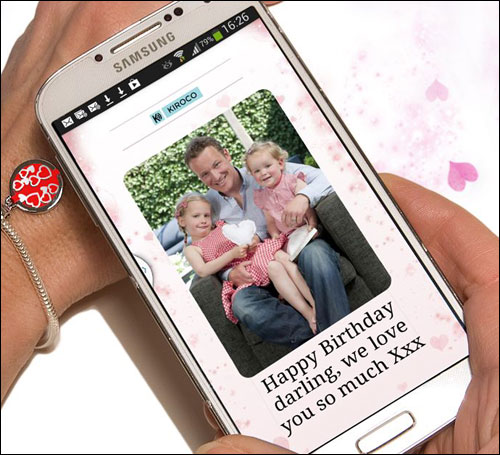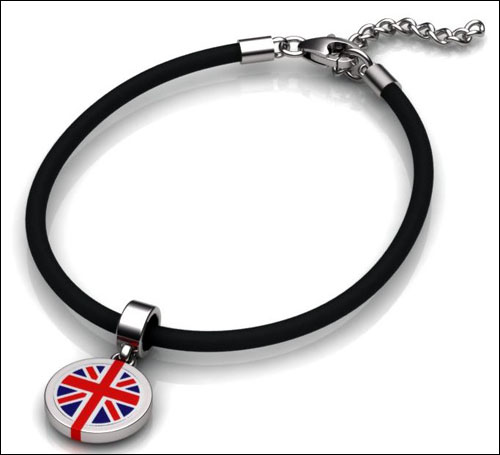British jewelry company Kiroco, a two-and-a-half-year-old startup, has released its first products: jewelry that employs Near Field Communication (NFC) RFID technology to deliver personal messages. The technology, known as “Kiroco Touch,” consists of an NFC tag built into each piece of jewelry, enabling consumers to buy a charm or pendant as a gift, and to create a video or text message for the recipient, who can then access that message by tapping an NFC-enabled phone against the item.
The technology was devised by the company’s founder, Nigel Townsend, a jeweler and the owner of Townsend Fine Jewellers, located in Weatherby, Yorkshire County. During the past few years, Townsend has observed an industry-wide decline in jewelry sales, as consumers are increasingly spending money on electronic gadgets, such as smartphones and tablets. To target these consumers, he conceived of a solution that would gel technology with jewelry, by allowing jewelry buyers to create and store cloud-based personal messages that would be available only to an intended recipient possessing both the jewelry and a phone approved to read the tag built into it.

The products consist largely of bracelets, charms and pendants, all manufactured by Kiroco. An NFC chip and antenna are built into all of the company’s charms and pendants, composed of crystal and sterling silver—or, in the case of one product, white metal. The solution’s creation required more than two years of research and development, according to Fiona Cartwright, Kiroco’s U.K. sales and marketing director. The challenge, she explains, was to figure out a means of embedding an NFC tag that would transmit through metal—a solution for which the company now has patents pending. Cartwright says the company is working with multiple NFC RFID tag vendors, though she declines to name them, or to describe the tag-embedding method.
Kiroco’s products are available through the company’s website. To send a message, a jewelry purchaser creates a username and a password to open an account, and then inputs the telephone number of the gift’s recipient, so that her smartphone is the only one authorized to read the tag built into that piece of jewelry. The buyer can then input text (up to 140 characters) or record a 10-second video message that is stored on a cloud-based server, along with the username, the password and the recipient’s phone number.
Before shipping the item to the customer, a Kiroco staff member uses an NFC-enabled mobile phone to read the item’s RFID tag, thereby linking the tag’s ID number with the details of the order. This includes the buyer’s information and message, as well as the phone number authorized to read that tag.
When the recipient receives her jewelry, the product materials instruct her to download the free Kiroco Touch app from Google Play’s website. She then simply taps her phone against the jewelry. The phone’s built-in NFC reader captures the tag’s ID number and forwards that data to the server, along with its own phone number. Then phone then receives the recorded message for the jewelry owner to view, and she is also prompted to use her phone to take a picture of the charm or pendant. When other messages are sent, the phone app emits a pinging sound to alert her to a new message.
The solution provides an alternative to traditional communication methods, such as texting or social networks, since it is private, personal and secure. For example, Cartwright says, while text messages can be viewed by others who have access to the phone, the Kiroco Touch messages can be viewed only by one particular phone when it is tapped against a specific piece of jewelry. In that way, she adds, individuals may feel free to be more personal or emotional in composing their messages. What’s more, the messages can be collected and stored on the server indefinitely for a monthly charge of 99 pence (about US$1.60), as part of a “Timeline” feature. If the Timeline is not purchased, each new message would overwrite the one before it.
Although the system currently operates only with relatively new Android phones (only recent Android phone models have built-in NFC readers), the company is presently investigating a solution supported by Apple iPhones. The firm is also developing a solution that would enable a group of friends who own Kiroco jewelry to create a network in which one member could send a message that all those within that group could then access via the NFC chips embedded in their jewelry.
“We all have our own reasons for feeling passionate about this product,” Cartwright states. While Townsend was motivated by a wish to send private personal messages to his wife while he was away on business, she says, she likes the idea of storing personal messages from her parents on the server as well, linked to a particular jewelry item. In fact, she notes, even after many years of collecting and storing messages, an individual could gift the jewelry to someone else—a daughter, for instance—who could continue to access those messages.
Kiroco is not currently using the NFC tag ID as an inventory-tracking tool to identify which products may be in stock. The initial focus of the technology, Cartwright explains, is simply to provide a service to customers. However, she adds, the company may consider other uses of the NFC technology in the future. The firm does store the ID numbers of all of its tags, however, in order to prevent the counterfeiting of tags and products.
Since the product’s launch last week, in conjunction with the Wearable Technology Conference and Expo, in London (for which it earned the Best Innovation Award), “sales are going very well,” Cartwright reports. The company is presently in discussions with several retailers about selling the product at their stores, as well as with phone manufacturers that might offer the product to accompany the sale of a phone. She says the firm is talking to businesses in Europe, United States, the Middle East and Asia.


